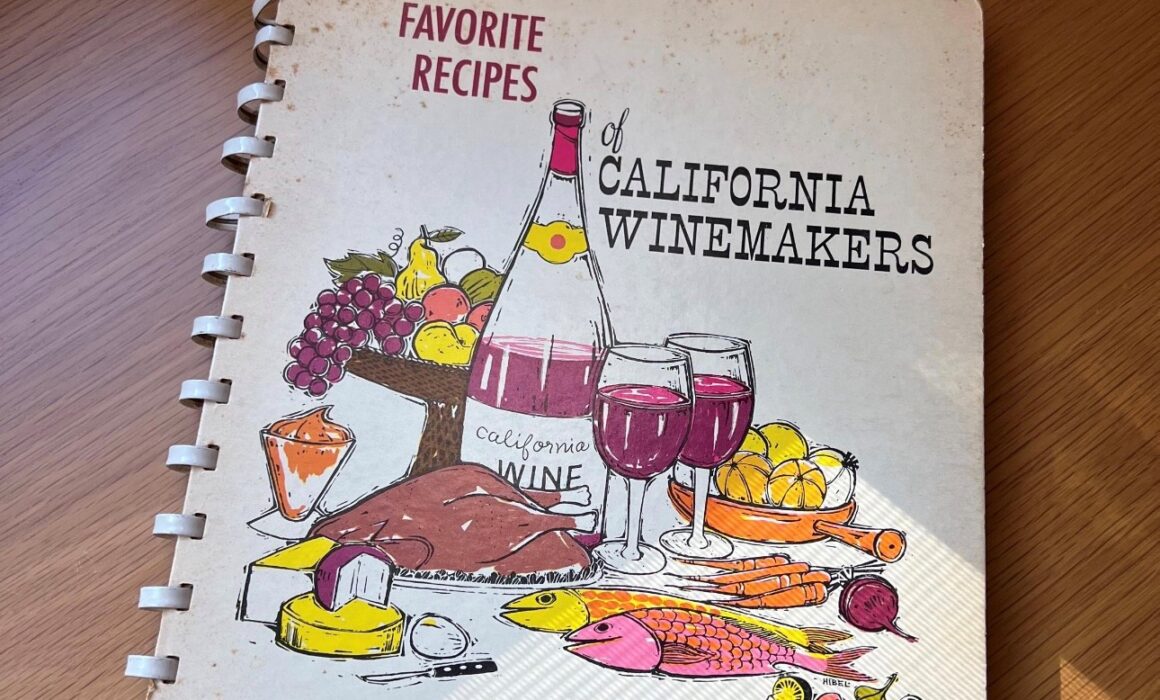A Look Back: Favorite Recipes of California Winemakers
By Virginie Boone
In 1963 the Wine Advisory Board of California published a spiral-bound cookbook called “Favorite Recipes of California Winemakers.” More than 200 individuals contributed, “California winemakers, their wives and families, their colleagues and companions… they are the authors of this book, which is dedicated to a simple truth known for thousands of years in countless countries: that good food is even better with wine.”
Clearly the book considered winemakers to always be male. The Home Advisory Service of Wine Institute also assisted, as did staff members from UC Davis and Fresno State, both institutions recognized for their contributions to the “high quality of California wines.” To demonstrate how nascent wine was to most readers at the time, the Wine Advisory Board was sure to add that, “For those not familiar with the terms, viticulture is the science of grape growing; enology is the science of winemaking.”
It’s a total trip to go back this far and get a bird’s eye view of how wine was being promoted to a new generation of home cooks and potential wine drinkers.
An introduction written by editor Lee Hecker called “The Lore and Lure of Wine Cookery,” describes how Homer told us the earliest civilized Greeks used wine for cooking as well as for quaffing and that later under the Romans wine was “ever more at home on the range.” But you have to love his line that, “As the basic drink throughout the ancient world, wine was even supplied regularly to slaves, to keep them in good health.”
Hecker ends with a noble plug for personal choice when it comes to pairing food and wine and the confidence one should have in California wines, writing, “The fact that there is no rule on choice but that of personal preference. If your wine is from California, whatever its type you can enjoy it with confidence. For California provides wines made 100% from the juice of true vinifera [Hecker’s bold] grapes, used for great wines for centuries in famous wine-growing regions of the world. And the strictest of all quality regulations are those imposed by the State of California for California wines.”
I bet. Then there’s a quick breakdown of California wine types and wine uses. Here’s what it says.
Appetizer Wines (to enjoy before dinner or as a refreshment anytime): Sherry, Vermouth, Flavored Wines
Red Dinner Wines: Burgundy (includes Pinot Noir, Gamay, Red Pinot), Claret, Rose, “Vino” Types, Chianti
White Dinner Wines: Sauterne, Rhine Wine (Riesling, Traminer, Sylvaner), Chablis
Dessert Wines: Port, Tokay, Muscatel, Angelica, Cream (Sweet) Sherry
Sparkling Wines: Champagne, Sparkling Burgundy
Clearly, we had not adopted our own nomenclature for California wines, still looking at wines from a European point of view. There’s also an entire section on Punches so that “with wine on hand, you can whip up a colorful, crowd-pleasing punch (hot or cold) that makes partying easier every way.”
I kind of like this one from Paul R. Heck of Korbel Champagne Vineyards:
After-Dinner Peachie
4 small (half-dollar size) ripe peaches, peeled
¾ cup California brandy
1 tablespoon powdered sugar
1 large bottle California Sec of Brut Champagne, chilled
Pierce peeled peaches thoroughly with a fork. Place in small glass bowl. Pour over brandy, sprinkle with powdered sugar. Refrigerate overnight. When ready to serve, place each peach in a tall, clear, zombie-type glass. Gently pour Champagne over peach, filling glass 2/3 full. If peach is small enough to move in glass, the effervescence of the Champagne will cause the peach to swirl.
Other chapters include a recipe for Sonoma Steak Pot from John Pedroncelli of Pedroncelli Winery (to include a white dinner wine in the sauce), a Quick Friday Minestrone from Mrs. August Sebastiani of Sebastiani Winery (with dry sherry), Beef Magnifique from Mrs. Frank H. Bartholomew of Buena Vista Vineyards, Chicken Zellerbach from J.D. Zellerbach of Hanzell, Stuffed Roasted Squabs from Mrs. Eugene P. Seghesio of Seghesio Winery, and Cauliflower Santa Rosa from Elmo Martini of Martini & Prati Wines. Each dish is accompanied by the author’s choice of California wine to accompany the menu.
A little tidbit within the book’s “Quick Tips for Beginning Cooks,” states that “every type of wine can be – and is – used for cooking. Wines labeled as ‘cooking wines’ are wines with a little salt added.” Did not know that.
From start to finish “Favorite Recipes of California Winemakers,” is a time capsule of 1960s America when people were just beginning to wake up to wine as a worthy part of a meal. That it was specifically intended as a way to promote California wine to home cooks everywhere makes it a valuable part of our wine history, a treasure for all times.


